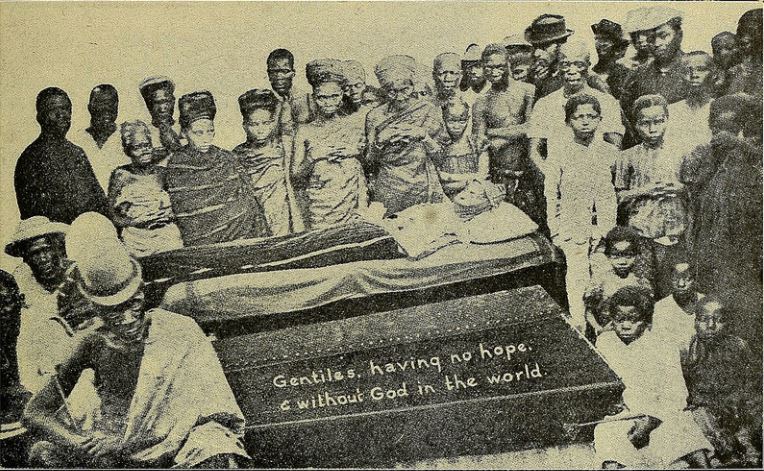A Corpse in a Terrible Frenzy

While I have too weak a stomach to enjoy zombie entertainments, there is something fascinating about stories of the re-animated dead such as the draugr. This particular narrative about a vengeful victim of witchcraft was written by John Payne, Bishop of Liberia, in the early 1850s. It is quoted in a Spiritualist publication and, as you’ll see by the author’s introduction to the story, the author puts an orthodox Spiritualist spin on it.
The unnamed author in a chapter called “Spiritualism in California,” cites, but does not describe an “account of the manifestation through a dead body,” which, he says, some people supposed was “intended as a deception.” Then he goes on:
“The incidents do not seem to me any more marvellous or extraordinary than many well-authenticated instances of “possession,” nor does it seem to me any more difficult for the unseen power which is at work among us, to influence a dead body than it does a living one…
“In the ‘Carrier Dove’ for October, a monthly published by the Foreign Committee of the Board of Missions, Protestant Episcopal Church, we have a narrative by Bishop [John] Payne [Bishop of Liberia], of an incident which occurred in Africa in his presence. He relates it as evidence of the superstition, etc., of the natives. With his inferences I have nothing to do. I extract the facts.
A HEATHEN AFRICAN SCENE
“It is now the middle of the rainy season, and torrents of water pour down almost every day. But the clouds appeared to be broken this afternoon, and I was glad to avail myself of the pleasant interval to visit two native villages, three miles from Cavilla, in which I preach statedly the blessed Gospel.
“The text from which I was preaching was, ‘Without God and without hope in the world.’
“I was proceeding, when quick, but stealthy footsteps, as of many, were heard approaching. The darkness spread over us by the heavy passing clouds, the theme of my discourse, and the solemn stillness pervading my attentive audience, contributed doubtless to produce the impression fastened upon my mind by the sound of the mysterious footsteps which now fell upon the ear. It was that of a funeral procession moving rapidly through a graveyard.
“The wailing which broke forth at the instant the procession entered the yard in which we were assembled, soon discovered to us that we were in the presence of the dead.
“The deceased was the wife of a male relative of Nye-Praa, the chief in whose house we were assembled. She was a native of Cape Palmas, fourteen miles distant. When taken seriously ill, she had been carried to that place, partly to be with her nearest relations, and partly to escape the witchcraft which it was believed had caused her illness and was procuring her death. But she died.
“The relations of her husband at Sede, contrary to custom, had received no intimation of this until her corpse appeared in their midst. It was an appalling moment. The coffin, as usual, consisted of a small canoe cut off at both ends. Into this the deceased, wrapped in mats and cotton cloth, was laid. It was borne on the heads of two of her nearest relatives, and followed by a few more of these, chiefly females. And now followed the heathen scene. Arrived in front of Nye-Praa’s house, the corpse seemed to be seized with a sudden terrible phrensy.
The bearers reeled, staggered, dashed wildly from side to side in the court, and then wheeling about ran back furiously to the entrance of the town. Again it approached the devoted house of Nye-Praa. Nearer and nearer it drew, until it lay at full length upon the thatched roof of the house. The male population of the village had now all gathered around, and one, or rather many of them, addressed the deceased: ‘Don’t be afraid; declare plainly who has killed you, and you shall be avenged.’ Again the corpse was in motion. Withdrawing to the distance of twenty paces, it now again rushed toward the house, and, with all the impetus which the two bearers could give, was thrown against it. This was repeated until the dead seemed as if she would destroy the bearers, or the house which sheltered her murderers.”
The Sacred Circle, Vol. 1, Judge Edmonds, Dr. Dexter, O.G. Warren, editors,1855, pp. 384-5
I have not been able to locate the original “Carrier Dove” article so I don’t know how Bishop Payne framed the story. It is certainly ambiguous about the role of the coffin bearers: are they being dragged or doing the dragging of the bewitched corpse? Is this an African variant on cruentation where the bearers throw the body at a suspect’s house and see if he/she flinches? The passage about “lay at full length upon the thatched roof of the house” is rather puzzling, as the traditional Liberian house has a high conical roof. How did the bearers get up there or how did the coffined body get down?
Other details on this story? I have a terrible phrensy to know more. Chriswoodyard8 AT gmail.com
Chris Woodyard is the author of The Victorian Book of the Dead, The Ghost Wore Black, The Headless Horror, The Face in the Window, and the 7-volume Haunted Ohio series. She is also the chronicler of the adventures of that amiable murderess Mrs Daffodil in A Spot of Bother: Four Macabre Tales. The books are available in paperback and for Kindle. Indexes and fact sheets for all of these books may be found by searching hauntedohiobooks.com.
